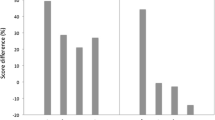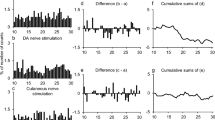Summary
-
1.
Electrophysiological properties of single units in the inferior colliculi of 9 big brown bats,Eptesicus fuscus, were studied by recording the responses of single units to pure tone pulses and frequency-modulated signals. Evoked potentials were also measured from 5 locations.
-
2.
Single units are tonotopically organized with low frequency units located dorsally, high frequency units ventrally and intermediate frequency units interposed between them.
-
3.
Response patterns of 230 units could be classified into six types but most units fired either tonically or phasically.
-
4.
The peak latency of the evoked potential is betwen 3.5 and 4.0 ms. Those of the 188 on-responding units are mainly between 5.0 and 12.5 ms.
-
5.
Threshold curves of the evoked potentials are broadly tuned to frequencies from 10 to 90 kHz. Those of single units are either broad, narrow or closed (upper threshold). The Q10−dB values range between 1.3 (BF = 31.4 kHz) and 39.5 (BF = 79 kHz) but the majority are below 24. Threshold curves of 4 on-off responders and 3 inhibitory units were also measured.
-
6.
The impulse-count functions of 109 units were either monotonic or non-monotonic. Among the 89 non-monotonic units, 17 had upper thresholds so that they stopped discharging action potentials when the stimulus became very intense (Fig. 10C). A series of the impulse-count function of 29 units to pure tone pulses and different FM stimuli were also measured.
-
7.
Minimum thresholds of 112 units to pure tone pulses and FM stimuli with different rates were compared. Most units had equal thresholds or within ±5 dB difference in thresholds to both pure tone pulses and FM stimuli. However, 15 units exclusively responded only to pure tone pulses.
-
8.
Responses of 35 units to different stimulus duration were studied. The number of impulses of single units either monotonically or non-monotonically increased with stimulus duration or maintained a rather constant level regardless of stimulus duration. Response patterns of some units changed drastically with stimulus duration.
-
9.
Responses of 33 units to different stimulus repetition rate were studied. The number of impulses of 26 units reached to the maximum value at a specific stimulus repetition rate. Those of the remaining 7 units either reached to the maximum over a broad range or maintained a rather constant level regardless of the repetition rate of a stimulus.
Similar content being viewed by others
Abbreviations
- BF :
-
best frequency
- BRR :
-
best repetition rate
- CF :
-
constant frequency
- FM :
-
frequency modulated
- MT :
-
minimum threshold
References
Feng AS, Simmons JA, Kick SA (1978) Echo detection and target-ranging neurons in the auditory system of the bat,Eptesicus fuscus. Science 202:645–648
Griffin PR (1958) Listening in the dark. Yale University Press, New Haven ((Reprinted by Dover New York (1974))
Grinnell AD (1963) The neurophysiology of audition in bats: temporal parameters. J Physiol (Lond) 167:67–96
Grinnell AD (1973a) Neural processing mechanisms in echolocating bats, correlated with differences in emitted sounds. J Acoust Soc Am 54:147–156
Grinnell AD (1973b) Rebound excitation (off-responses) following non-neural suppression in the cochlea of echolocating bats. J Comp Physiol 82:179–194
Jen PH-S (1978) Electrophysiological properties of auditory neurons in the superior olivary complex of echolocating bats. J Comp Physiol 128:47–56
Jen PH-S, Schlegel PA (1980) Neurons in the cerebellum of echolocating bats respond to acoustic signals. Brain Res 196:502–507
Jen PH-S, Vater M, Harnischfeger G, Rübsamen R (1981) Mapping of the auditory area in the cerebellar vermis and hemispheres of the little brown bats,Myotis lucifugus. Brain Res 219:156–161
Kiang NY-S (1965) Discharge patterns of single nerve fibers in the cat's auditory nerve. Res Monogr 35. M.I.T. Press, Cambridge, Massachusetts
Neuweiler G (1980) Auditory processing of echoes: peripheral processing. In: Busnel RG (ed) Animal sonar systems. Plenum, New York, pp 519–548
Pollak GD (1980) Organization and encoding features of neurons in the inferior colliculus of bats. In: Busnel RG (ed) Animal sonar systems. Plenum, New York, pp 549–588
Pollak GD, Bodenhamer RD (1981) Specialized characteristics of single units in inferior colliculus of mustache bat: frequency representation, tuning and discharge patterns. J Neurophysiol 46:605–620
Pollak GD, Marsh D, Bodenhamer R, Souther A (1978) A single unit analysis of the inferior colliculus in unanesthetized bats response patterns and spike count functions generated by constant frequency and frequency-modulated sounds. J Neurophysiol 41:677–691
Simmons JA (1973) The resolution of target range by echolocating bats. J Acoust Soc Am 54:157–173
Simmons JA, Fenton MB, O'Farrel MJ (1979) Echolocation and pursuit of prey by bats. Science 203:16–21
Suga N (1973) Feature extraction in the auditory system of bats. In: Møller AR (ed) Basic mechanisms of hearing. Academic Press, New York, pp 675–744
Suga N, Jen PH-S (1977) Further studies on the peripheral auditory system of CF-FM bats specialized for fine frequency analysis of Doppler-shifted echoes. J Exp Biol 69:207–232
Vater M, Schlegel P (1979) Comparative auditory neurophysiology of the inferior colliculus of two molossid bats,Molossus ater andMolossus molossus. II. Single unit responses to frequency-modulated signals and signal and noise combinations. J Comp Physiol 131:147–160
Vater M, Schlegel P, Zöller H (1979) Comparative auditory neurophysiology of the inferior colliculus of two molossid bats,Molossus ater andMolossus molossus. I. Gross evoked potentials and single unit responses to pure tones. J Comp Physiol 131:137–145
Author information
Authors and Affiliations
Rights and permissions
About this article
Cite this article
Jen, P.H.S., Schlegel, P.A. Auditory physiological properties of the neurones in the inferior colliculus of the big brown bat,Eptesicus fuscus . J. Comp. Physiol. 147, 351–363 (1982). https://doi.org/10.1007/BF00609669
Accepted:
Issue Date:
DOI: https://doi.org/10.1007/BF00609669




